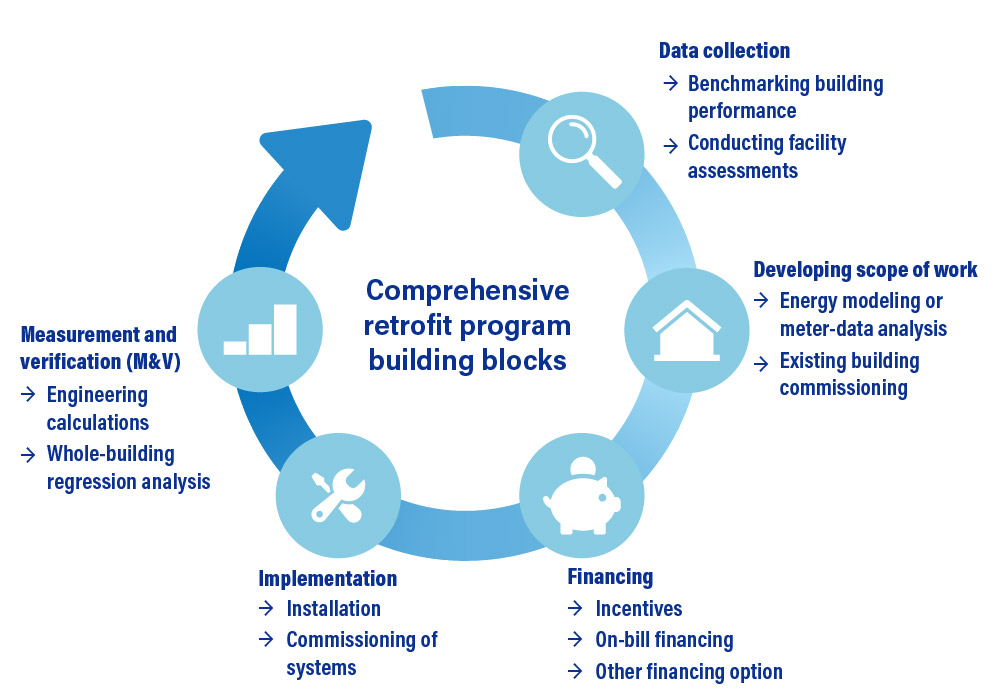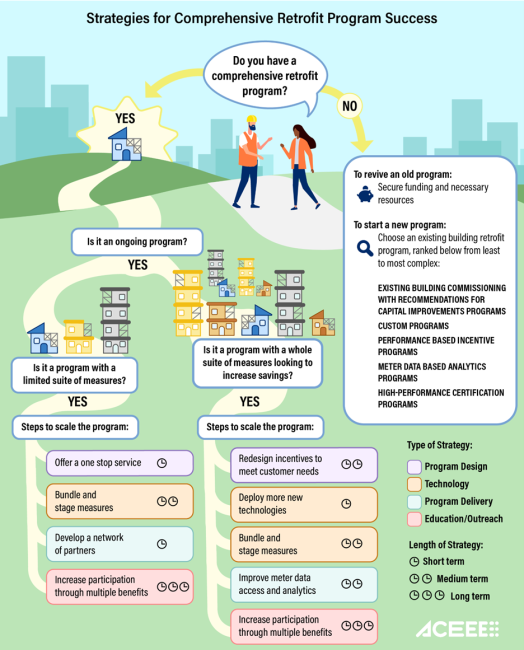Comprehensive retrofits of commercial buildings can reduce their energy use by up to 40% but are not happening anywhere near the scale needed to meet climate goals, according to a report released today by the American Council for an Energy-Efficient Economy (ACEEE). With new federal funds available for such energy-saving upgrades, the report offers a roadmap for how utilities and policymakers can start or expand robust retrofit programs that include more than just lighting.
The research finds that more utility programs have emerged in recent years to offer “deep” or “comprehensive” commercial retrofits. These retrofits include multiple energy efficiency measures that often upgrade heating, cooling, lighting, and other systems. Yet there are still far too few of these programs, which deliver energy savings 2.5 to 7 times greater than approaches involving single measures such as lighting—often the easiest step.
Deep retrofits are critical for climate action. More than half of U.S. commercial buildings were built before 2000. They do not meet today’s more efficient codes and often lack products and technologies that can save the most energy. Even many newer buildings that comply with more-recent codes do not perform as intended, either due to faulty installation, lack of maintenance, or normal wear and tear.
In today’s report, which updates earlier research, ACEEE analyzes 50 utility programs in the United States to identify and recommend approaches for retrofitting commercial buildings. Many of these programs offer limited data because they are still in early stages or the COVID-19 pandemic slowed their progress. As a result, most program data are from 2018 or 2019. Because many programs are still new, determining their success will require additional time and data.
Overall, we see that utilities have made progress and use a variety of strategies to improve their programs. Several good practices highlighted in ACEEE’s 2014 analysis, such as offering low-cost energy assessments and collecting energy-use data, are now the basis for identifying and assessing program savings. ACEEE also explored the issue in a 2005 report.
These programs help customers design, finance, and implement deep retrofits of commercial buildings. They also help assess and verify the expected levels of energy savings, which range from 10% to 40%.
We group programs with the above scope of services into five categories, each with varying strengths: (1) existing-building commissioning (EBCx) with recommendations for capital improvements, (2) custom programs, (3) performance-based programs, (4) programs based on energy consumption patterns, and (5) programs encouraging high-performance certifications.
The report includes cases studies of programs that are overcoming barriers to comprehensive retrofits. For example, Pacific Gas & Electric’s Whole Building Performance Based Program Offering quantifies savings at the meter, overcoming challenges around measuring the energy reductions from multi-measure projects.
Another example is Seattle City Light’s Energy Efficiency as a Service pilot. The program uses service agreements to deliver deep energy retrofits, requiring participating buildings to reduce electricity consumption by at least 25%. The pilot tests a way to address the problem of split incentives—the discrepancy between the party that pays for the retrofit and the party that financially benefits from it. Split incentives prevent building owners from investing in deep retrofits.
We find that programs based on performance or energy consumption patterns can scale comprehensive retrofits but are often more administratively complex and costly to implement. We also find that programs collaborating with existing market providers are likely to see greater participation.
Our research shows that programs must communicate a deep retrofit’s full range of benefits in ways that captivate consumers and motivate them to go beyond single-measure upgrades. We identify eight effective strategies that program administrators can adopt to help comprehensive retrofit programs best serve their customers.
- Secure funding. Combining federal, state, and local funding can help develop new programs and expand existing ones.
- Offer a one-stop service. Designing programs to offer one-stop service including energy assessments, financing options, technical assistance, and post-installation follow-up can ensure continuous savings.
- Redesign customer incentives. Providing upfront and performance-based incentives, rebates, and financing options for comprehensive retrofits can help customers overcome initial and total project cost barriers.
- Bundle and stage measures. Bundling a combination of measures with long-term paybacks and short-term paybacks can create an acceptable return and much higher value for customers. Splitting a retrofit into stages can make the process and the investment less overwhelming.
- Deploy new technologies. Creating a package that incorporates energy-saving measures and grid-interactive efficient building technologies can drive additional savings and demand reductions. The technologies may vary based on customer needs and utility program goals.
- Develop a network of partners. Identifying key partnerships can enable utilities to offer turnkey services and increase program participation and success.
- Improve access to meter data and enable analytics. Accelerating the deployment of analytical tools that leverage smart meters and data management systems can provide better visibility into building operations and improve accuracy of measurement and verification.
- Increase participation by noting multiple benefits. Characterizing and quantifying the multiple benefits from comprehensive retrofits can further outreach to decision makers, get more buildings to do retrofits, and provide policymakers compelling evidence of the value of comprehensive retrofits in meeting city, state, and federal energy and climate goals.
Figure 4. Strategies for program administrators to scale their program and best serve their customers






